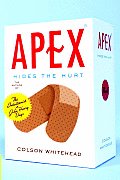

His survival and his family’s depend on his performance, and the dire complexities of his world far overbalance the ephemeral, trivial subtleties of J.’s bogus receipts and mooching. While John Henry’s contest has its absurdities too, they are not of his making or under his control.

Many critics overlooked this problem with the novel, since they were so enamored of Whitehead’s ability to capture this mostly white media culture so well, relishing the in-joke. or to mock him, mostly because J.’s endeavor is so very meaningless, a parody of the superficial media. It is hard to tell, however, if Whitehead intends the comparison to ennoble J. The storyline parallels John Henry’s famous steel-driving contest: pitted against a steel-driving machine to see which one can perform faster, John Henry wins but dies after doing so. Sutter, the protagonist, is a junketeer journalist who, in the course of trying to set a marathon event record, ends up covering a celebration of John Henry in the steel driver’s purported hometown in Virginia. John Henry Days is a more traditional narrative, and that may be its biggest flaw. The central metaphors of Whitehead’s novels work best when they are atypical, freeing the author from the trap of an excessive seriousness-which he often humorously derides, but from which his second novel regrettably suffers. Still, noir does work, beyond survival and suspense, with lust and sexual attraction, and Lila Mae and Natchez, Fulton’s nephew, might have taken some time out from their cogitations to humanize an otherwise densely thematic story. The novel often has the imaginative quality of hindsight’s stark clarity, like the Star Trek episode (from the original series, of course) where the crew travels back in time to 20th-century America, trying to fit into contemporary mores and technology as they execute their mission.īecause noir can’t easily accommodate subtle characterization and emotion, Lila Mae’s detachment is forgivable.

The reader becomes palpably aware of just how constructed these iconic American images and tropes are, made familiar because of the white faces and dominating white perspective behind the illusion in, ironically, a black-and-white, noir, exceedingly “empirical” world. The novel works its thematic magic by locating racial perspectives and ideas in a seemingly familiar, benign environment-mid-century America and elevators-where they have an almost science-fiction allure. Lila Mae’s extraordinary talents in Intuitionism suggest that the Black social experience may be uniquely qualified to forge this neo-mystical world. As elevators rise, Fulton suggests, so too must the evolutionary imperatives of humanity to transcend sensory limits-what Lila Mae calls “white people’s reality,” represented by the Empiricists-and the fraudulent social reality that it has spawned. Lila Mae ends up pursuing the Intuitionists’ Holy Grail: philosophical notebooks written by their founder, James Fulton, that offer a deep metaphorical vision for racial and social identity. And adding to her isolation, she lives far from family. Lila Mae is a master Intuitionist, and she also happens to be the first Black and female elevator inspector. As she investigates an elevator accident, she must negotiate the politics of two opposing schools of thought within the Department of Elevator Inspectors: the Empiricists, who inspect by observation, and the Intuitionists, who inspect by extrasensory perception. The Intuitionist depicts Lila Mae, an elevator inspector with visions. Whitehead’s impressive 1999 debut, The Intuitionist, an allegorical fantasy, established Whitehead as a writer with a most idiosyncratic vision. His characters’ occupations allow Whitehead to investigate-in an often sardonic, gumshoe style-our culture’s preoccupations with race, history, and memory. Historically, jobs have been identity straitjackets for African-Americans, and Whitehead reminds us that the culture of work is a nexus for society’s hierarchies and values. A job, in Colson Whitehead’s narrative universe, is never just a job: it is the prospecting tool the author uses to prise open the seams of identity, culture, and race that so tenuously hold together his protagonists’ insulated worlds.


 0 kommentar(er)
0 kommentar(er)
